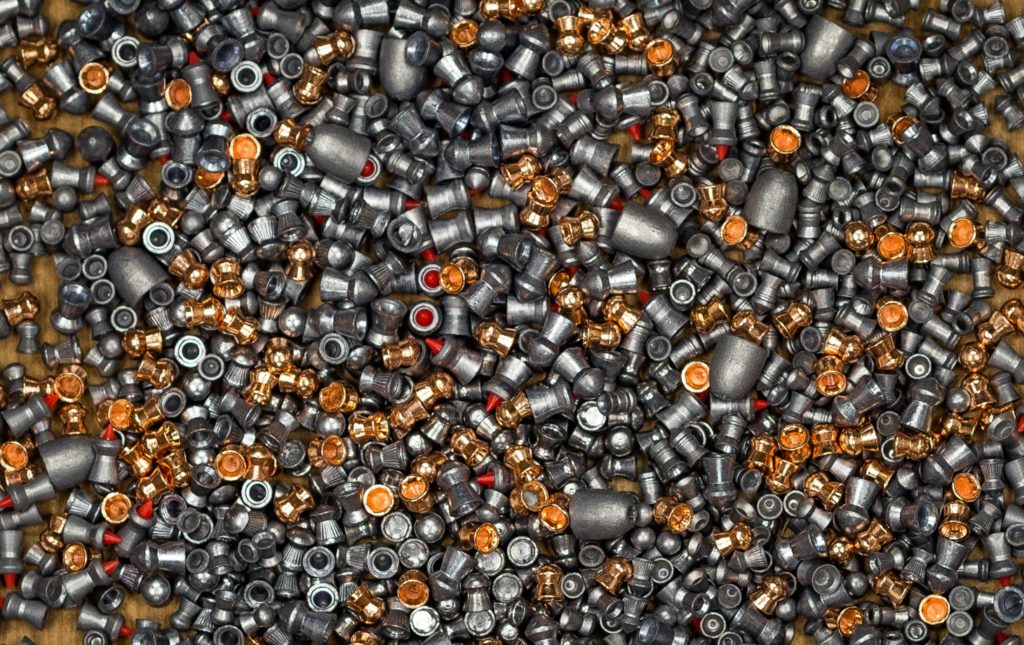The modern air rifle is a fantastic firearm alternative for preppers. A high-quality “pellet gun” can cover many realistic gun-related prepping needs — such as hunting and self-defense — without some of the legal, practical, or personal-ethics considerations of firearm ownership. In fact, there are many ways in which an inexpensive air gun is arguably a superior option for preppers:
- Air gun ammo is insanely cheap to stockpile in bulk
- Air gun pellets are easy to make with some lead and a mold for casting
- Air gun ammo is lightweight and compact
- An air gun spring or piston will keep going for decades after your rifle runs out of ammo
- Children can safely use an air gun for small game
- Air guns can be easily and legally suppressed in almost all states
- You can buy air guns that will take down anything from a squirrel to a bear
- Air guns don’t require a background check in all but a handful of states
Sure, despite the above positives, most of us would rather defend our property or hunt rabbits with a standard firearm. But firearms aren’t practical or realistic for everyone. Sometimes local laws get in the way, and in other cases living arrangements, relationships, or personal choices take guns off the table as a prep.
So the air gun is definitely worth taking seriously as a prepping tool — even if you rely on traditional firearms as your primary tools, the air rifle can act as a worthwhile compliment for well-rounded, long-term preps.
There’s some great history to air guns as preps: when Lewis and Clarke set out on their famous expedition across the US, they made good use of a .46-caliber Girandoni air rifle for hunting and impressing the Native Americans they encountered in their travels. So the air rifle is as old-school of a wilderness survival tool as the Bowie knife or the tomahawk.
Deeper details below the fold about how modern air guns work, piston vs. spring vs. compressed air debates, and what air rifle ammo is the best.
Keep these tips in mind when buying an air gun for prepping:
- Experts recommend that most people rely on a spring-powered break-barrel style air gun. They are simpler and more reliable than other forms, which is obviously a plus for prepping. You operate these basic but accurate air guns by cocking a spring, which sends a pellet flying down the barrel after pulling the trigger.
- The best general-purpose air gun ammo for prepping is whatever flavor of domed .22 pellet works best in your gun. The .22 caliber is versatile, deadly, easy to find, and offers plenty of ammo options, and the domed pellets can add some expansion and a little extra lethality.
- Shot placement is critical for clean air gun kills, because air gun pellets poke a tiny hole all the way through the target, and don’t generally expand or fragment like firearm ammo.
- You cannot use a regular firearm optic on a spring-powered air gun without breaking the optic, so you’ll want a dedicated air gun optic to help with shot placement.
- Practice makes perfect, because you can’t get good, lethal groups without it. Luckily, air rifle practice is cheap, safe, and fun.
- Pre-charged Pneumatic (PCP) air guns are a more expensive, complex alternative to spring-powered air guns. These guns are powered by a tank that’s filled with compressed air, which makes them much closer to a regular firearm in terms of rate of fire and available calibers. The extra steps and gear needed for a PCP gun make them harder to rely on as a long-term prep, but they give you more lethality and the ability to use regular firearm optics.
- Big-bore air gun calibers (.30 cal and up) can work for large game and home/property defense. Almost all these big guns are PCP, though, so don’t start there — start with a simple .22 caliber break-barrel, an appropriate optic, high-quality pellets, and tons of practice, before moving up to a big-bore.
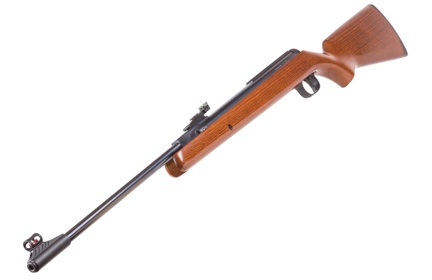
Best for most:
Diana 34 Air Rifle .22
The best spring-powered air rifle for preppers is the $280 Diana 34 in .22 caliber. Generations of shooters have used this spring-powered wonder gun to take birds and small mammals. High-quality German parts, solid accuracy, and a user-replaceable spring that lasts for decades make this a prep that even a firearm owner with a full-blown doomsday arsenal should have on-hand in a disaster.
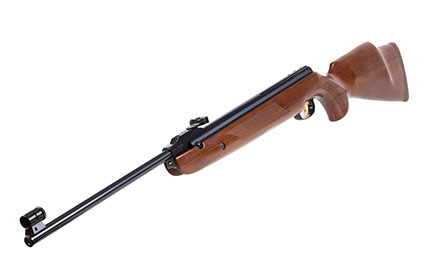
Top of the line:
Beeman R9 Air Rifle .22
If you want an upgrade in materials and accuracy, the best prepper air rifle is the $400 Beeman R9 in .22 caliber. Beeman is another storied German air gun brand, and the R9 is one of its most popular products. Famous for its simplicity and accuracy, the match-grade R9 features a high-quality hardwood stock and a world-famous two-stage adjustable trigger.
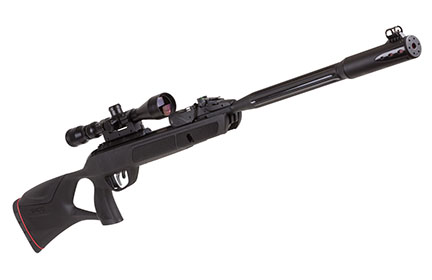
New hotness:
Gamo Swarm Fusion 10X Gen2
Preppers who want all the new hotness — gas piston power, a synthetic stock, and faster follow-up shots — should get the $280 Gamo Swarm Fusion 10X Gen2, an innovative, magazine-fed break-barrel that comes with a scope included. The Swarm is lightweight, accurate, durable, and relatively quiet (for a piston gun). The 10-round magazine design means that cocking it also reloads it, getting you back on-target that much faster. It’s more complicated than our spring-powered picks, though, with more parts that can break, so this is strictly for preppers who strongly prefer a gas piston or who feel the faster followup shots are worth a bit of extra risk in a long-term grid-down.
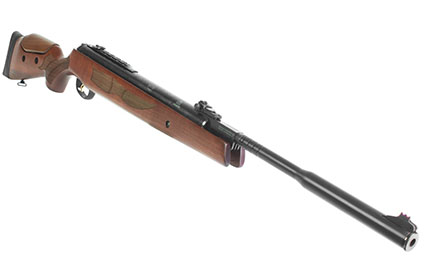
Varmint killer:
Hatsan 135 QE Vortex Air Rifle
If you want to move up to a caliber that can take larger game like raccoons and other varmints, the vast majority of your options will be PCP guns. But the $270 Hatsan 135 QE Vortex is an excellent piston-powered air rifle that you can get in .25- and .30-caliber versions. This air rifle is very heavy and very hard to cock, but it will greatly expand your air gun hunting (and defense) options in a long-term grid-down scenario if you have the muscle to make it work.
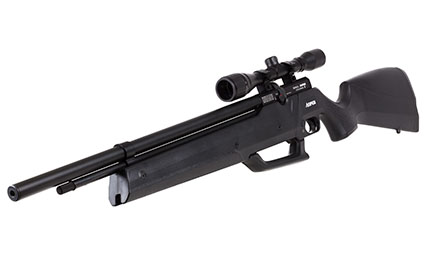
Pump it up:
Seneca Aspen Multi-Pump PCP Air Rifle
Pump-action air guns use a pump that’s built into the gun to charge up a chamber with compressed air, and so-called “multi-pump” air guns let you control the velocity of a shot — along with its power and range — by charging up an air chamber with multiple successive pumps. The best multi-pump air gun for preppers is the $400 Seneca Aspen PCP Air Rifle, a .22-caliber air gun that will let you reach out to long distances by charging up the chamber with up to 60 pumps. You get 10 rounds of repeating fire in a PCP airgun, without the need for an external pump. As with the Gamo Swarm, this is more complex, with more breakable parts, so weigh the costs vs. benefits carefully for your specific prepping needs.
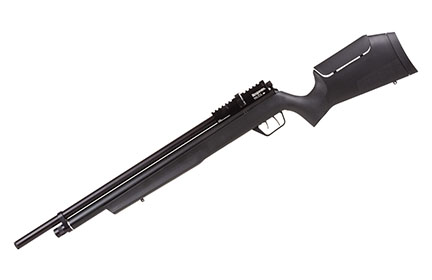
Repeater:
Benjamin Marauder PCP Air Rifle .22
Moving up to a PCP gun has its tradeoffs — mainly the need for a specialized external pump or air bottle — but in return you get more power and the ability to use regular firearm optics.
Our pick for the best PCP air gun for preppers is the $580 Marauder in .22 with match barrel for extra accuracy and a Picatinny rail for mounting your favorite optic. The Marauder is quiet and deadly accurate, and this particular model features a two-stage trigger. The 10-shot capacity means fast followups, making it an ideal small game hunter.
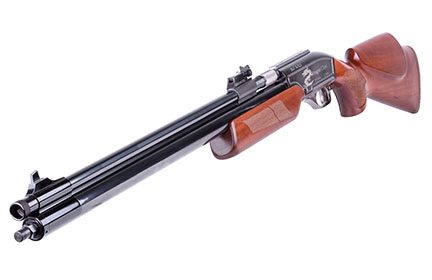
Better than a bow:
Seneca Dragon Claw Air Rifle .50
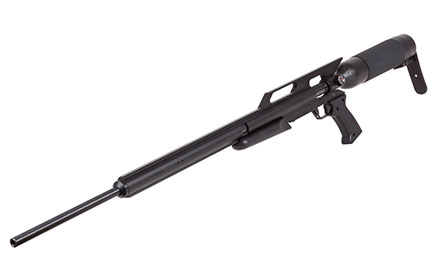
Big Tex:
AirForce Texan Big Bore Air Rifle .45
For home/property defense and hunting larger game, the big-bore PCP air guns can hang with a firearm in terms of lethality at close range. The $650 Seneca Dragon Claw is a .50-cal monster of a gun that can also fire specially designed arrows in addition to bullets. The Dragon Claw can take deer-sized game at up to 50 yards, and even bigger game closer in. It’s no joke, and the accuracy is outstanding. Whatever you’re hunting, thumping it with a .50-cal bullet at 679 feet per second (FPS) will take it down.
If you want even more range and knockdown power, and are willing to pay for it, the $1,030 AirForce Texan in .45 ups the muzzle velocity to 1000 FPS. This is the current king of the hill in big-bore air rifles, and when paired with the right scope you can take deer-sized game at up to 80 yards, depending on ammo selection, shooter skill, and the direction and strength of the wind.
How we picked the best pellet guns for preppers
We stayed away from tacticool and exotic offerings, and stuck to tried-and-true, no-frills guns with proven track records of performance and reliability.
We also didn’t get sucked into the feet-per-second (FPS) arms race that modern air gun manufacturers like to promote. When it comes to bucking the wind and delivering lethal energy to a target downrage, there’s more than just muzzle velocity at work. Caliber and pellet selection matter, too, so we want to combine the right ammo with a prepper-appropriate air gun that doesn’t sacrifice qualities like accuracy and durability to chase inflated FPS numbers.
This guide recommends traditional metal spring air guns over the gas piston alternatives, for reasons we go into in the section titled, “The Spring vs. Piston Debate”.
Best air gun optics
Many air guns are limited in range, with the result that iron sights work well for them. But even in the closer, sub-100-yard ranges these guns are effective at, a scope can still help with shot placement. This is especially important with smaller calibers, since good shot placement can let a critter-killing gun take down a larger animal like a wild hog in an emergency.
Warning: Never shoot at larger animals with a small caliber firearm unless you have to — you’re more likely to just injure them, not kill them, and that’s inhumane.
Keep these basics in mind when picking an air gun optic:
- Spring-based air guns (including piston guns) will damage standard firearm optics, so only use a dedicated air gun optic on such guns.
- Parallax adjustment is critical, since most shots are close-range. Firearm-style fixed 100 yard parallax is not useful on an air gun, and parallax should always be adjustable down to 20 or so yards (10 yards is even better).
- Reticles with subtension markings are preferred, since pellets fly in more of an arc than firearms so you need to judge elevation and windage.
- Subtension type — mils vs MOA — is less important that just having the marks and knowing the reticle well enough to use them (e.g., at 10 yards I hit 2 hash marks down with this gun, dead center at 25-30 yards, one hash down at 50 yards, etc.).
- Too much magnification is as bad as no magnification, since it limits your field-of-view. So don’t overdo it on the magnification.
Note for gun nerds: It’s worth repeating a third time that the recoil impulse on a spring-powered gun — it travels back-to-front, vs. front-to-back on a firearm, and the curve is shaped differently — will ruin even the toughest military-grade firearm optics. So your favorite high-end or even budget scope maker probably does not make a niche scope that works with a spring gun, which means the list below is likely populated by brands you wouldn’t consider for your Gucci doomsday rifle build. It’s a different market for different guns with different ranges and capabilities and requirements.
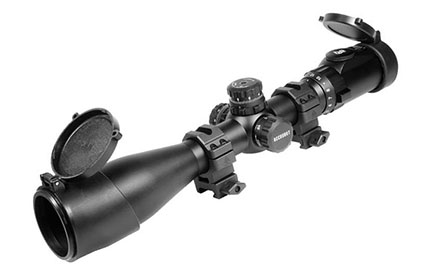
Leapers UTG 3-12x44 AO Accushot SWAT Rifle Scope
The best air rifle optic for preppers is the $120 Leapers UTG 3-12×44 AO Accushot SWAT Rifle Scope. This reasonably priced air rifle scope has an etched glass reticle that is very durable, and it sports just the right amount of magnification. The 30mm tube has bombproof construction, with a side parallax adjustment that’s easy to dial in for close shots.
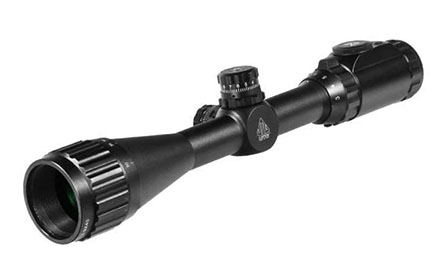
Leapers UTG 3-9x40 AO True Hunter Rifle Scope
The best budget air gun optic is the $100 Leapers UTG 3-9x40AO True Hunter Rifle Scope, which boasts an illuminated mil-dot reticle that’s great for low-light conditions and a parallax adjustment that starts at just 5 yards out. This inexpensive air gun scope is our go-to because we can trust it on a break-barrel, and does exactly what it’s supposed to all day long.
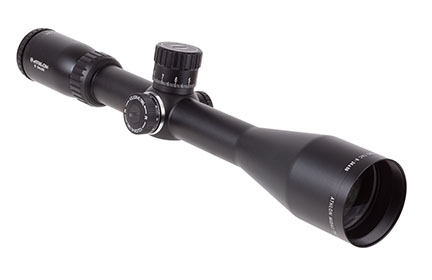
Athlon Optics 6-24x50 Midas TAC
The best premium air rifle optic for preppers is the $630 Athlon Optics 6-24×50 Midas TAC, a first-focal-plane (FFP) scope that lets you keep the same holdovers as you zoom in on the target. This makes the Midas ideal for longer-range shots, where you’re using all of the magnification and making detailed windage and elevation adjustments for precision shooting. The Midas’s glass is crystal clear, and the unit’s weight is reasonable for its size and features.
Best air gun pellets
The best air gun caliber for preppers is .22, and all of the air guns in this guide are at least this caliber. The .22 caliber pellet is the choice of hunters because it has enough mass to maintain accuracy at high velocities, and its larger size increases the odds that you’ll hit a vital organ and do more damage to soft issue. This ammo is also very widely and cheaply available, and there are many high-quality hunting pellet options in it.
The experts we’ve interviewed recommend domed pellets for accuracy and lethality, so all of our recommendations are domed.
The three types of game most commonly hunted with a .22 caliber air gun are birds, rabbits, and squirrels. You can move up to slightly larger critters like racoons and opossums, but as always, shot placement and accuracy are what will make the difference between a clean kill vs. a wounded animal that gets away.
The .25 caliber pellet is gaining in popularity with hunters, but ammo availability and selection are more limited, so we still recommend the .22 for prepping purposes.
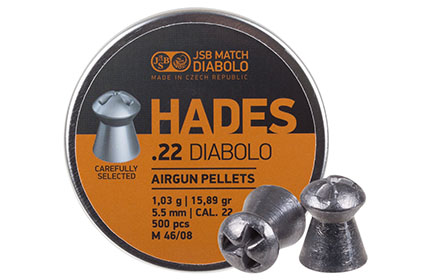
JSB Match Diabolo Hades .22 cal
When it comes to picking specific pellets, every gun is different, and you have to experiment to find out which pellets work best in your rifle. But you should start your search with the $22 (for 500) JSB Match Diabolo Hades .22 cal, an exceptional pellet that combines near match accuracy with a small amount of expansion for added knock-down power.
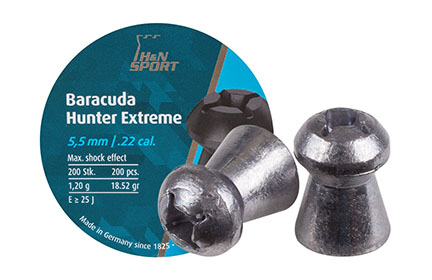
H&N Baracuda Hunter Extreme Pellets .22 cal
Also great are the $11 (for 500) H&N Baracuda Hunter Extreme Pellets .22 cal, another outstanding, near-match domed pellet with top-shelf performance. Pick up batch of these bad boys and run a few through your rifle, because if these work well in you’re gun then your search is over.
Best big-bore pellets
With a larger caliber air gun, like a .45 or .50 you can take any sized game in North America. Here’s a video of a hunter on safari taking an Africa Cape Buffalo with our top .50 cal pick, the Seneca Dragon Claw:
You could also do home and property defense with an air rifle this size in a survival situation, if a firearm isn’t an option for this role.
The one downside of a larger caliber air gun is that you have to move up from spring-powered guns to PCP guns, which means adding a high-powered pump (and another point of failure) to your preps.
The larger caliber air rifle pellets are relatively expensive to stock up on, but they’re just a projectile that you could make with a bullet mold and some lead if you absolutely had to. We don’t recommend planning to make your own ammo in a SHTF situation, but with an air gun this is a lot more realistic for most of us than with firearm ammunition, because it doesn’t involve any dangerous chemistry.
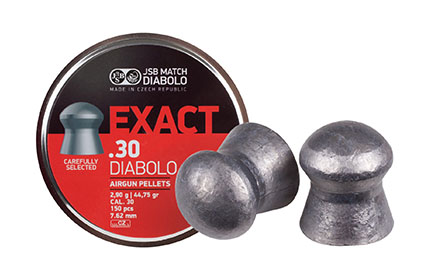
JSB Diabolo Exact Pellets in .30 cal 150 ct
The best .30 caliber ammo for preppers is the $18 (for 150) JSB Diabolo Exact Pellets in .30 cal at 44.75 grains — this is one of is one of the best air guns rounds ever made.
As for .45 and .50 caliber ammo, the best ammo selections here are extremely air gun-dependent — far more so than is the case for smaller calibers. So we can only confidently suggest ammo for the specific big-bore guns we’ve recommended in this guide. If you have a different big-bore rifle, then you’ll need to do your own research and experimentation to figure out what’s best.
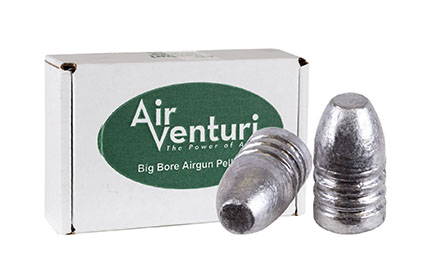
Air Venturi .45 Cal, 300 Grains, Round Nose Flat Point
The AirForce Texan in .45 likes longer slugs in the 300 grain weight, like $30 (50 count) Air Venturi .45 Cal, 300 Grains, Round Nose Flat Point. These slugs have really stood out in our time with this rifle, and we’d feel confident stacking them deep for everything from big game hunting to home and property defense.
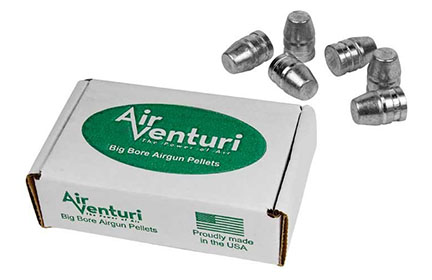
Air Venturi .50 Cal, 336 Grains, Flat Nose, 50ct
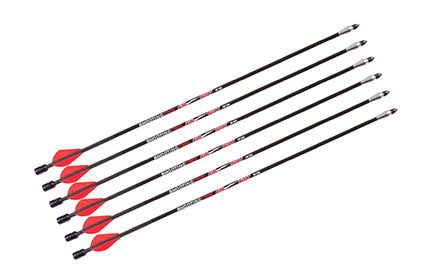
Air Venturi Air Bolt, 6 pack .50 cal
The .50 caliber Seneca Dragon seems to prefer a shorter projectile, in our experience. We like the $30 (per 50) Air Venturi .50 Cal Flat Nose in 336 Grains, which have proven to work well. The $100 Air Venturi Air Bolt, 6 pack .50 cal gives the gun more even more lethality for use on really large game, like bears or exotics.
How PCP air guns work
Pre-charged pneumatic (PCP) air rifles are the fastest growing group of air guns, and they offer following advantages over spring-powered guns:
- More caliber choices, which mostly means larger hunting calibers for larger game.
- Higher rate of fire (in both sem-automatic and bolt action formats), since you don’t have to stop and re-cock a heavy spring after each shot.
- More shots in a row without a refill/recock.
- Optic availability is greatly increased, because you can use regular firearm optics without damaging them.
- PCP guns are less sensitive to proper hold, since they don’t depend on a reciprocating mass (i.e. the spring) that has to finish moving before the pellet even starts to travel down the barrel.
To make a PCP air gun work as a prep, you’ll need a way to refill it with compressed air. Unfortunately, the kind of compressor you can get at your local hardware store for filling tires and running pneumatic tools isn’t anywhere close to being up to the task of filling a 3,000 PSI tank.
Here are your options for keeping your PCP gun full:
- Use compressed air bottles, regularly refilled at a paintball or scuba shop. This option is cheapest, and offers multiple air gun refills when filled to 4500.
- Buy an expensive, high-end compressor powerful enough for PCP use.
- A hand pump, which offers grid independence but is physically challenging to use.
As a prepper, you’ll definitely want a hand pump for grid-down scenarios, but you don’t want to use that pump for regular practice (unless you’re a masochist). This means you’ll need to pair the hand pump with either bottles or a compressor.
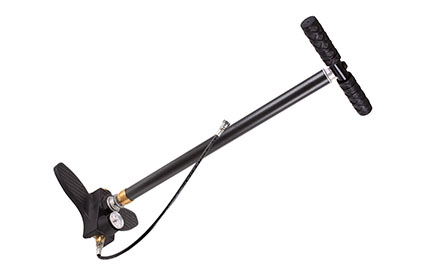
Air Venturi MK4
The best air gun hand pump is the $200 Air Venturi MK4. This pump can be rebuilt from spare parts if it breaks, and maintained to last indefinitely. With the MK4, a PCP air gun, a way to cast bullets from soft metal, and some luck, you could be sending .30 to .50-caliber bullets downrange for decades after everyone else is out of ammo in a total grid-down scenario.
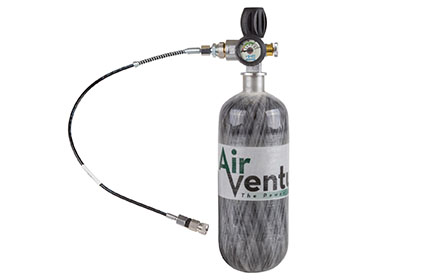
Air Venturi Carbon Fiber Tank
The best bottle is the $350 Air Venturi 100 cu-in Carbon Fiber Tank. This portable tank is about the size of a football, but it holds more air than most air guns so you can get complete fills from it. It’s also very lightweight, which makes it packable in the field or on a bug-out.
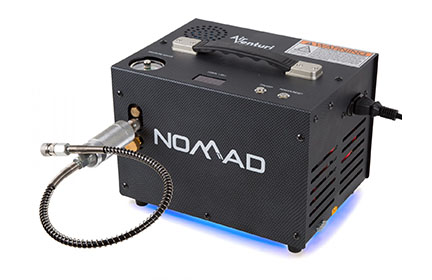
Air Venturi Nomad compressor
The best compressor is the $700 Air Venturi Nomad Air Compressor, for its compact size and reasonable price relative to ability. The Nomad has the ability to fill both bottles and guns directly, and Air Venturi’s compressors have a proven track record of quality and reliability.
Air gun lethality and range
Air gun pellets often go all the way through an animal without stopping, because pellets don’t expand and fragment the same way modern firearm self-defense and hunting bullets do. Pellets also don’t go nearly fast enough to inflict the same kind of temporary cavitation-based wounds caused by much faster-moving firearm bulles.
What the air rifle pellet’s over-penetration, lack of expansion, and lack of temporary cavitation all mean is that the size of the air gun pellet is the size of the hole you’ll create in the target critter, period, with no bonus damage from tumbling, fragmenting, or high-velocity energy absorption. So there’s a direct correlation between the size of an air gun pellet and its “stopping power” on live game, because a bigger pellet means a bigger wound channel and a greater chance of hitting a vital organ.
The other important side effect of the air gun’s lower impact energy is that shot placement matters even more for air guns than it does for firearms (and it matters a lot for firearms). You really need to poke a hole through the brain or the heart to drop even small game like squirrels or rabbits, which typically means you need to be able to hit within an inch of your point of aim every time. Therefore the range at which you can hunt with an air gun is whatever range at which you can group all your shots within an inch of the dead center of the bullseye.
In theory, in a SHTF situation you could hunt game of almost arbitrarily large size with even the smaller caliber air rifles, if you can drive the pellet right through the brain. But such trick shots are risky and extremely hard to make, and are far more likely to result in injury to an animal. So while you definitely should never hunt larger game like deer or hogs with a small-caliber (.177 to at least .25) pellet, in a desperate survival situation you could theoretically make it work.
The spring vs. piston debate
If you’ve spent any amount of time shopping for survival air guns, then you already know that many preppers strongly favor gas piston-powered air guns over the spring-powered guns our experts recommend in this guide. Here’s what’s going on with that whole debate, and why this guide comes out on the traditional metal spring side of things.
As a source of power to send a pellet flying down a barrel, a compressed metal spring in a tube has serious advantages: it’s lightweight, reliable, resistant to common environmental hazards like dust and corrosion, and dead simple.
But springs have two downsides:
- Repeatedly compressing and releasing a spring causes it to lose its springiness over time. This mechanical wear problem shows up in break-barrel air guns as a loss of muzzle velocity over the course of thousands or tens of thousands of shots fired, as the spring loses some of its oomph and mellows out.
- A spring that’s left compressed for a long time can also “take a set” — meaning it gets slightly deformed and doesn’t expand back to its full length. The risk of a quality spring taking a set is quite small, and depends greatly on the quality of the spring, but it can happen.
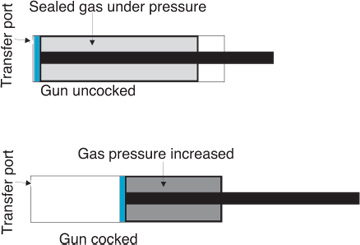
Gas piston air guns — also called “gas ram” or “gas spring” air guns — were introduced as a way to eliminate the above problems with springs. These pistons work by sealing a bit of gas in a tube, and when the gun is cocked the piston manually compresses the gas. When the trigger is pulled the gas decompresses rapidly and sends the pellet flying through the gun.
Because the thing being repeatedly compressed and released is a bit of gas and not a metal spring, mechanical spring wear is not an issue in these guns. In theory, a gas piston should last indefinitely, and a gas piston air gun should have the same muzzle velocity after a million shots fired as it does on the very first shot from the factory.
But notice the qualifier “in theory,” above. Gas pistons aren’t perfect, and they have the following downsides:
- A gas piston is more complex than the simple metal spring. There are simply more things to go wrong (see the rest of this list).
- Gas pistons have seals to keep the gas from escaping and the pressure from going down, and if one of those seals cracks then the piston can fail.
- If a gas piston fails and you don’t have a spare, the gun is a paperweight. It either works or it doesn’t, unlike with a spring, where you may lose some power over the years but it still works.
So while the experts we talked to love gas piston rifles, on balance they favor traditional metal springs for long-term survival. These springs are inexpensive and easy for preppers to stock up on and store, and with a tool like the $100 Air Venturi Rail Lock Compressor you can replace them if something goes wrong.
